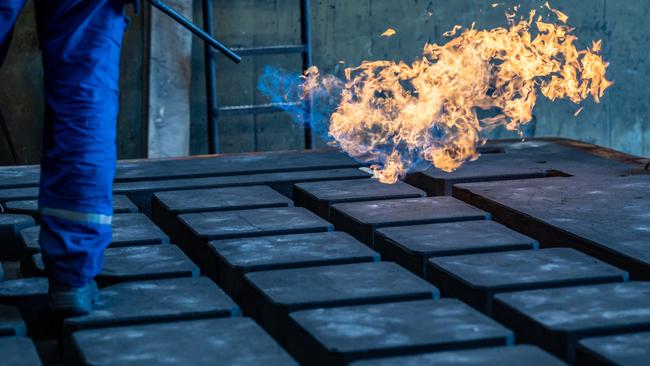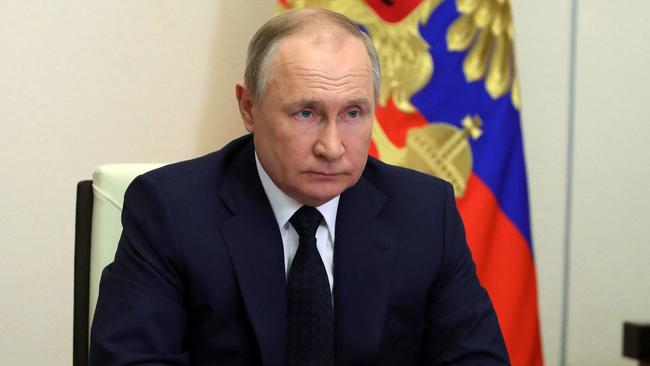Gas prices at record high in Europe as Vladimir Putin burns $US10m gas a day in energy war
European gas prices have hit a record high as Russia just burns off the fuel, sparking accusations of stoking tensions with Europe.

European gas prices have hit a record high of more than 343 euros ($494) per megawatt-hour as Russia just burns off fuel, sparking accusations of stoking tensions with Europe.
The commodity is in short supply since Russia slashed exports to Europe via the key Nord Stream 1 pipeline in June and industry may face rationing once the weather turns cold. Prices are more than 10 times the level of those in America as traders and utilities scramble to secure supplies before then.
Fertilizers Europe, the industry association, has said that 70 per cent of production on the Continent had been curtailed by high gas prices, underscoring that the energy crisis is starting to spread across industries and to threaten sectors as diverse as glassmaking and food production.
Fertiliser companies including Yara, a Norwegian company, and BASF, based in Germany, have begun to shut down facilities.
CF Industries, the American group that owns the Billingham fertiliser plant in northeast England, said this week that it would halt production at its ammonia plant, which will lead to a loss of carbon dioxide output.
Meanwhile, a quarter of Britain’s small and medium-sized companies have said that energy bills will be unsustainable within 12 months. According to a survey by YouGov, 5 per cent of all smaller firms are already unable to afford their energy bills. This figure rises to 26 per cent among those that are experiencing higher prices.
Seventy-five per cent of those experiencing higher energy bills say they will have to pass costs on to customers. In some cases, the bills will be “much higher”, according to the survey.

Russia is burning off an estimated $US10m ($14.5m) million of natural gas a day from a single plant, leading to accusations that President Vladimir Putin is deploying his country’s vast energy reserves as a weapon against Europe.
Satellite monitoring of radiant heat levels indicates that about 4.34 million cubic metres of gas a day is being “flared” from a stack at the Portovaya LNG facility near the border with Finland.
Experts suggest that the flaring, so close to the EU, could be a signal to Western governments that gas is available – if they soften their opposition to Mr Putin’s war in Ukraine.
Rystad Energy, the Oslo-based energy research company that conducted the monitoring, said: “The flaring flame is highly visible, perhaps indicating that gas is ready and waiting to flow to Europe if friendly political relations resume.”
Gas flaring is the burning of excess or waste gas via stacks in the oil, chemical and gas industries.
Residents of eastern Finland have reported a constant flame visible on the horizon from the Portovaya facility, near a compressor station servicing the Nord Stream pipeline that sends Russian gas to Europe.
It began in mid-June, a month before Russia began maintenance on Nord Stream and reduced supply to 20 per cent of normal levels; a move widely seen as a ploy to deny energy to European states critical of Russia’s invasion.
Construction of the Portovaya LNG plant is incomplete, possibly having stalled as a result of sanctions.
Zongqiang Luo, senior analyst on gas and LNG at Rystad, said the quantity of gas being burnt made it unlikely it was test flaring as part of the commissioning process. It was more probably a result of “a lack of co-ordination between different operating segments”, he said.
Asked about a political tinge to the flaring, Mr Luo noted that the timing of it coincided with the reduction of flow through the Nord Stream pipeline.
“Why don’t you just burn the gas at the well head?” he asked. “You have to transport it, you have much higher costs. Why don’t you just reduce the production? Why send it all the way to this LNG plant to be flared and photographed by some Finnish residents?”
The plant is producing 9000 tonnes of CO2 each day.
Rystad said the flaring “raises a number of questions about Russia’s intent”, with gas exports to Europe down 77 per cent year-on-year this month, equivalent to more than 20 per cent of EU gas demand.
Germany has accused Moscow of using gas as a weapon to drive up prices and weaken the EU’s resolve over sanctions. Russia blames western sanctions for the high gas prices.
Gazprom, the Russian energy giant that runs Portovaya and Nord Stream, has not commented on the flare.
On a visit to Ukraine this past week, outgoing British Prime Minister Boris Johnson blamed the Kremlin for high energy prices in Europe. “If we’re paying in our energy bills for the evils of Vladimir Putin, the people of Ukraine are paying in their blood,” he said.
According to the World Bank, Russia burnt off 25 billion cubic metres of gas last year via thousands of flares, more than any other country.
Dr Mark Davis, head of Capterio, a London-based company specialising in capturing flared gas, said the flare in Portovaya was “particularly egregious” because it was close to a foreign state, “is substantial in size and it’s got a lot of black smoke”.
It had been going on so long that it was “not an accidental upset, it’s a substantial operational problem; quite probably related to an attempted start-up of the new LNG export terminal”, he said.
That could be linked to equipment failure, or the absence of technology denied to Russia by Western sanctions. “I believe this is flaring through deliberate choice and Gazprom could have stopped it, if nothing else, by shutting down the plant or the supply from the pipeline leading to the Nord Stream export line.”
However, the company may not have wanted to undertake a difficult restart, Davis added: “It might also be that they are flaring for political reasons, to make a statement. They may be saying, ‘We’re flaring because the West is blocking us getting critical equipment’.”
Professor Jonathan Stern, a research fellow at the Oxford Institute for Energy Studies, was sceptical of that idea. He said the flaring could be because of “constant changes in configuration of turbines at the [Nord Stream] compressor station” close to the LNG plant.
The turbines have been undergoing repairs as part of the controversial maintenance plan announced by Putin. “It would not be surprising that given the line is operating at about 20 per cent of its capacity, some of the surplus gas is being flared,” Professor Stern said.
In Finland the environmental impact of the flare is significant: the soot it produces blackens the surrounding snow, which absorbs more heat and so melting is accelerated.
****
The Russian-controlled Zaporizhzhya nuclear power plant in southeastern Ukraine has been reconnected to the grid after being damaged by shelling. Ukraine blamed the Russian military for the attack; Russian state media claimed that four Ukrainian shells struck a storage facility. International Atomic Energy Agency inspectors are expected to make an emergency visit to the plant in the coming week.
The Times



To join the conversation, please log in. Don't have an account? Register
Join the conversation, you are commenting as Logout